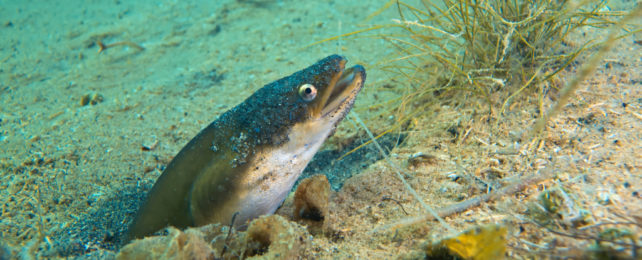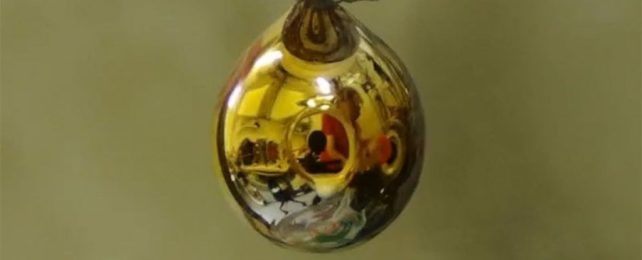Scientists Track Eels to Their Ocean Breeding Grounds in World-First

After generations of speculation, scientists have finally managed to track European eels the entire way back to their breeding grounds in the Sargasso Sea – following their movements thousands of kilometers along what is considered one of the most impressive animal migrations in nature.
Scientists are gushing with excitement because this is the first direct evidence of a long-suspected part of the eels' life cycle that was proposed almost 100 years ago.
Until now, no eggs or eels had been found in the North Atlantic Ocean's Sargasso Sea confirming this truly is where eels gather to breed.
"Eels have piqued the curiosity of scientists for millennia," study author and fish biologist Kim Aarestrup of the Technical University of Denmark said on Twitter.
"For the first time ever, we followed eels to their spawning grounds."
Way back in the early 1920s, Danish biologist Johannes Schmidt discovered eel larvae in the Sargasso Sea, far from their freshwater, estuarine, and coastal habitats in Europe and Africa.
Publishing his results in 1923, Schmidt foreshadowed the next century of research to understand how eels reproduce, describing his efforts as "disappointment alternating with encouraging discoveries and periods of rapid progress with others during which the solution of the problem seemed wrapped in deeper darkness than ever."
In the decades since, scientists have been trying to trace the line back to where eels go to breed – a task made harder by the many obstacles in the eels' way: dams, weirs, pollution, habitat loss and overfishing. A sharp decline in European eel (Anguilla anguilla) numbers since the 1980s has only made the task all that much harder, and more urgent.
But don't underestimate these enigmatic creatures. European eels migrate between 5,000 and 10,000 kilometers (3,100 to 6,210 miles) to spawn at sea, after which their larvae drift back towards land and the relative safety of rivers.
Using satellite tags, the researchers behind this latest discovery obtained tracking data from 21 female European eels as they navigated the last leg of their epic journey, southwest from the Azores, a volcanic archipelago in the North Atlantic Ocean, far west of Portugal.
Past research tracking eel migrations had shown eels from all over Europe converge around the Azores islands before departing for the Sargasso Sea, an ocean region bounded by four swirling ocean currents and named for its vast forests of Sargassum seaweed.
The eels were captured, tagged with detachable satellite trackers, swabbed for DNA testing, and released back into the Atlantic Ocean from the Azores islands back in 2018 and 2019.
Six eels reached the Sargasso breeding grounds months later with their satellite trackers still attached; data from 15 other eels were collected along the way. The longest recorded straight-line distance was 2,275 kilometers (1,410 miles).
"Their journey will reveal information about eel migration that has never been known before," says fisheries biologist Ros Wright of the UK Environment Agency, who led the study.
It's still unclear how the eels find their way to the Sargasso Sea or even how long their spawning season extends.
The swimming speed of the eels in this study, which averaged 6.8 kilometers (4.2 miles) a day, and the length of their marathon journey – which takes more than a year – suggests these long-haulers need to make a very calculated migration.
"Rather than make a rapid migration to spawn at the earliest opportunity, European eels may instead make a long, slow spawning migration at depth that conserves their energy and reduces mortality risk," Wright and team write in their published paper.
"This timing would enable the completion of their reproductive maturation before they arrive at the spawning area."
"It's also incredible to know they go way deeper than 1,000 meters on the way!" James Maclaine, a senior fish curator at the UK National History Museum, tweeted. That's plunging more than 3,280 feet down into darkness.
But questions remain over the eels' timing and navigation across thousands of kilometers in open ocean to reach the Sargasso Sea.
It could be that they sense Earth's magnetic fields like Chinook salmon (Oncorhynchus tshawytscha), which return to the exact stream where they hatched. Sniffing out olfactory cues or following ocean currents or temperature fronts are other possibilities, too.
While it might be a while yet before we untangle those threads, for now, this new study completes the map of eel migrations, placing the Azores at the center of conservation efforts to combat the eels' decline.
"This discovery emphasizes the role of the Azores in the life cycle of eels," says study author and fish ecologist José Manuel N. Azevedo from the University of the Azores.
"It will help scientists and conservationists to push for measures to restore eel habitats across the archipelago."
The research was published in Scientific Reports.



